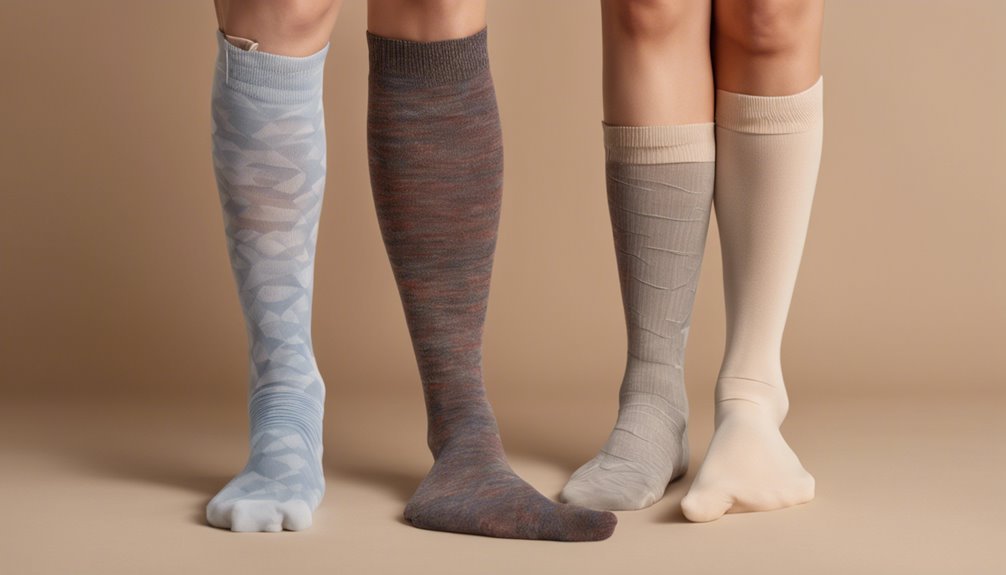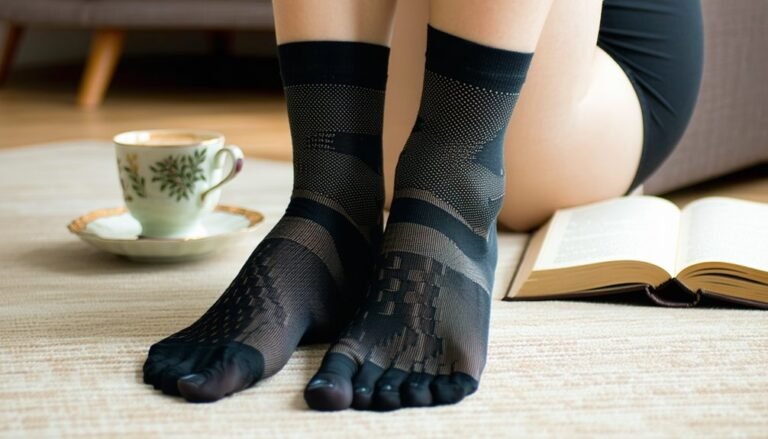Compression Socks vs. Regular Socks: Do They Improve Circulation?
Compression socks enhance circulation by applying targeted pressure to your lower legs, which helps improve blood flow and reduces swelling. Unlike regular socks, which focus on comfort and breathability, compression socks actively support your circulatory system, particularly beneficial during prolonged periods of sitting or standing. However, if you don't need medical support, regular socks may suffice. To better understand when to choose compression socks over regular options, exploring specific foot health considerations is essential.
Understanding Compression Socks

Compression socks are specialized garments designed to apply pressure to the lower legs, promoting better blood circulation. There are various compression sock types, including graduated, anti-embolism, and sport-specific options, each serving unique purposes. Graduated socks offer the most compression at the ankle, gradually decreasing up the leg. In contrast, anti-embolism socks are designed primarily for immobile patients. When considering sock material comparisons, you'll find options like nylon, spandex, and cotton blends. Nylon offers durability and elasticity, while cotton provides breathability and comfort. Understanding these distinctions helps you choose the right compression sock for your needs, ensuring you enjoy the freedom of movement while supporting your circulatory health. Investing in the right type and material can greatly enhance your overall well-being.
The Science Behind Circulation
While many may overlook the importance of circulation, it's essential for overall health and well-being. The circulatory system functions to transport oxygen, nutrients, and waste products throughout your body. Understanding blood vessel anatomy—arteries, veins, and capillaries—helps you appreciate how circulation affects your daily life.
Here's a table illustrating key components of circulation:
| Component | Function | Importance |
|---|---|---|
| Arteries | Carry oxygenated blood away | Crucial for delivering oxygen |
| Veins | Return deoxygenated blood | Essential for waste removal |
| Capillaries | Exchange nutrients and gases | Critical for cellular health |
Benefits of Compression Socks
Compression socks offer significant benefits, primarily through enhanced blood flow and reduced swelling risks. By applying graduated pressure, they help veins function more efficiently, promoting circulation. This can be particularly beneficial for individuals who spend long periods on their feet or are prone to swelling.
Enhanced Blood Flow
When you're on your feet for long periods or engaging in strenuous activities, you may notice your legs feeling fatigued or swollen. Compression socks are designed to enhance blood flow and support vascular health, making them a beneficial choice for active individuals. Here are some key advantages:
- Improved Circulation: Compression socks apply targeted pressure, promoting better blood flow back to the heart.
- Enhanced Oxygen Delivery: Increased blood flow helps deliver more oxygen to your muscles, reducing fatigue.
- Faster Recovery: Improved circulation aids in the removal of metabolic waste, leading to quicker recovery times.
- Support for Performance: By maintaining ideal blood flow during activities, you can enjoy better overall performance and endurance.
Incorporating compression socks into your routine can greatly boost your leg health and comfort.
Reduced Swelling Risks
Long periods of standing or physical activity can lead to fluid accumulation in the lower extremities, resulting in swelling. Compression socks are designed to combat this issue by promoting circulation improvement and facilitating swelling reduction. By applying graduated pressure, these socks encourage blood flow back to the heart, helping to prevent excessive fluid buildup.
| Feature | Compression Socks | Regular Socks |
|---|---|---|
| Pressure Level | High | Low |
| Circulation Improvement | Yes | No |
| Swelling Reduction | Significant | Minimal |
Wearing compression socks can enhance your comfort and well-being during long days, allowing you to maintain an active lifestyle without the discomfort of swelling.
Limitations of Compression Socks
Although compression socks offer various benefits, they do have limitations that users should be aware of. Here are some key points to take into account:
- Limited mobility: Individuals with severe mobility restrictions may find them difficult to wear or remove.
- Health conditions: Certain conditions, like peripheral artery disease, can worsen with compression usage.
- Improper usage: Wearing socks that are too tight or not fitted correctly can lead to discomfort issues and negate benefits.
- Fabric choices & duration impact: Low-quality materials may cause skin irritation, and prolonged wear can lead to discomfort, particularly in warmer climates.
Advantages of Regular Socks

Regular socks offer significant advantages, including enhanced comfort and breathability, making them suitable for daily wear. Their versatility allows you to pair them easily with various outfits, whether casual or formal. Additionally, they tend to be more cost-effective compared to specialized alternatives like compression socks.
Comfort and Breathability
While compression socks serve specific therapeutic purposes, regular socks offer distinct advantages regarding comfort and breathability. You'll find that regular socks are often made from breathable materials, promoting airflow and helping to regulate temperature, which enhances your overall comfort levels. Here are some key benefits:
- Softness: Regular socks usually feature soft fabrics that feel pleasant against the skin.
- Moisture-wicking: Many are designed to wick away sweat, keeping your feet dry and comfortable.
- Flexibility: They allow for greater movement without restriction, enhancing your freedom of motion.
- Variety: Available in numerous styles and materials, you can select options that suit your personal preferences and activities.
Everyday Versatility
The comfort and breathability of regular socks make them a versatile choice for everyday wear. They easily adapt to various settings, whether you're heading to the office or enjoying a casual outing. Regular socks are designed for comfort, allowing your feet to breathe while providing support throughout the day. Their lightweight fabric makes them ideal for athletic use, ensuring you stay comfortable during exercise or sports activities. Plus, they come in a range of styles and colors, allowing you to express your personal style effortlessly. Unlike compression socks, which have specific medical uses, regular socks offer the freedom to choose what suits your lifestyle best, making them an essential item in your wardrobe for both casual and active occasions.
Cost-Effectiveness
When considering cost-effectiveness, regular socks typically offer a more budget-friendly option compared to compression socks. A thorough cost analysis reveals that investing in regular socks can lead to long-term savings due to their affordability and versatility. Here are four key advantages:
- Lower Initial Investment: Regular socks are generally less expensive, allowing for bulk purchases.
- Durability: Many regular socks are designed to withstand frequent wear, reducing replacement costs.
- Less Maintenance: Regular socks don't require special washing or care, saving time and effort.
- Multi-purpose Use: They can be worn in various settings, making them a practical addition to your wardrobe.
When to Choose Compression Socks
How do you know if compression socks are the right choice for you? You should consider wearing them when you have specific conditions like varicose veins, chronic venous insufficiency, or if you're at risk for deep vein thrombosis. They're particularly beneficial during long periods of standing, sitting, or travel. If you experience swelling, discomfort in your legs, or fatigue, compression socks might provide relief. It's important to wear them as directed; improper use won't yield the desired benefits. Compression socks can enhance circulation, helping you feel more energetic and comfortable throughout your day. Always consult a healthcare professional before starting any new treatment to make sure it aligns with your unique health needs.
Making the Right Choice for Your Feet
Choosing the right type of sock can profoundly impact your comfort and foot health. It's crucial to evaluate various factors when deciding between compression socks and regular socks. Here are some key points to keep in mind:
- Foot Health Needs: Assess any specific conditions like swelling or pain that may require compression.
- Sock Materials: Opt for breathable, moisture-wicking fabrics to enhance comfort and prevent odor.
- Activity Level: Reflect on your daily activities; high-impact activities may necessitate more support.
- Fit and Compression Level: Confirm the sock fits well and provides the appropriate level of compression for your needs.
Frequently Asked Questions
Can Compression Socks Be Worn Overnight?
You might wonder if wearing compression socks overnight is beneficial. Nighttime usage can enhance circulation benefits, but it's crucial to consult a healthcare professional to verify they're appropriate for your specific needs and circumstances.
Are There Any Side Effects of Wearing Compression Socks?
Wearing compression socks can pose risks like skin irritation or discomfort if worn too long. It's vital to monitor your wearing duration and consult a healthcare professional to mitigate any potential side effects effectively.
How Do I Choose the Right Compression Level?
To choose the right compression level, consider your needs and consult a professional. Compression levels range from mild to extra firm. Also, pay attention to sock materials for comfort and breathability during wear.
Can Regular Socks Offer Any Circulation Benefits?
You'd think regular socks might boost circulation, but the benefits comparison reveals otherwise. They lack the targeted compression needed for circulation enhancement, making them less effective than specialized options for those seeking genuine improvement.
Are Compression Socks Suitable for Everyone?
Compression socks aren't suitable for everyone. Those with certain medical conditions, like peripheral artery disease, should avoid them. Additionally, consider sock materials; breathable options can enhance comfort without compromising circulation benefits for those who can wear them.







